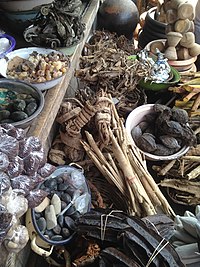
DNA barcoding of flowering plants in Sumatra, Indonesia
Sign Up to like & getrecommendations! Published in 2019 at "Ecology and Evolution"
DOI: 10.1002/ece3.4875
Abstract: Abstract The rapid conversion of Southeast Asian lowland rainforests into monocultures calls for the development of rapid methods for species identification to support ecological research and sustainable land‐use management. Here, we investigated the utilization of… read more here.
Keywords: dna barcoding; analysis; flowering plants; sumatra indonesia ... See more keywords

Susceptibility of spring‐flowering garden plants to herbivory by mule deer
Sign Up to like & getrecommendations! Published in 2018 at "Wildlife Society Bulletin"
DOI: 10.1002/wsb.864
Abstract: Many people look forward to spring flowers, only to discover that mule deer (Odocoileus hemionus) have eaten the sprouting plants and flower buds. One potential method to prevent this problem is to grow unpalatable flowering… read more here.
Keywords: deer; mule deer; flowering plants; spring ... See more keywords

Zygotic Embryogenesis in Flowering Plants.
Sign Up to like & getrecommendations! Published in 2021 at "Methods in molecular biology"
DOI: 10.1007/978-1-0716-1335-1_4
Abstract: In the context of plant regeneration, in vitro systems to produce embryos are frequently used. In many of these protocols, nonzygotic embryos are initiated that will produce shoot-like structures but may lack a primary root.… read more here.
Keywords: vitro systems; embryogenesis flowering; embryogenesis; zygotic embryogenesis ... See more keywords

Artificial FLOwering plants in Reducing Anxiety and depressive symptoms following Acute Coronary Syndromes (A-FLORA-ACS): a randomised controlled trial
Sign Up to like & getrecommendations! Published in 2018 at "Heart and Vessels"
DOI: 10.1007/s00380-018-1314-2
Abstract: Patients often experience emotional distress after acute coronary syndrome (ACS). These may lead to symptoms of depression or anxiety and greater morbidity/mortality. We sought to determine whether flowering plants in the coronary care ward reduced… read more here.
Keywords: anxiety; symptom scores; flowering plants; acute coronary ... See more keywords

Chloroplast phylogenomics and character evolution of eastern Asian Astragalus (Leguminosae): Tackling the phylogenetic structure of the largest genus of flowering plants in Asia.
Sign Up to like & getrecommendations! Published in 2020 at "Molecular phylogenetics and evolution"
DOI: 10.1016/j.ympev.2020.107025
Abstract: Astragalus, as the largest genus of the flowering plants, is well-known for its high species richness and morphological diversity. Previous studies suggested that many of the subgenera of Astragalus are not monophyletic and the phylogenetic… read more here.
Keywords: astragalus; chloroplast; largest genus; flowering plants ... See more keywords

Evolutionary Insight into the Clock-Associated PRR5 Transcriptional Network of Flowering Plants
Sign Up to like & getrecommendations! Published in 2019 at "Scientific Reports"
DOI: 10.1038/s41598-019-39720-2
Abstract: Circadian clocks regulate the daily timing of metabolic, physiological, and behavioral activities to adapt organisms to day-night cycles. In the model plant Arabidopsis thaliana, transcript-translational feedback loops (TTFL) constitute the circadian clock, which is conserved… read more here.
Keywords: transcriptional network; flowering plants; clock; clock associated ... See more keywords

Asynchrony among insect pollinator groups and flowering plants with elevation
Sign Up to like & getrecommendations! Published in 2020 at "Scientific Reports"
DOI: 10.1038/s41598-020-70055-5
Abstract: Mountains influence species distribution through differing climate variables associated with increasing elevation. These factors determine species niche ranges and phenology. Although the distribution patterns of some specific insect groups relative to elevation have been determined,… read more here.
Keywords: pollinator; flowering plants; abundance; elevation ... See more keywords

What is the age of flowering plants?
Sign Up to like & getrecommendations! Published in 2022 at "Journal of experimental botany"
DOI: 10.1093/jxb/erac130
Abstract: The origin of flowering plants (angiosperms) was one of the most transformative events in the history of our planet. Despite considerable interest from multiple research fields, numerous questions remain, including the age of the group… read more here.
Keywords: flowering plants; age; group; age angiosperms ... See more keywords

Contrasting Rates of Molecular Evolution and Patterns of Selection among Gymnosperms and Flowering Plants
Sign Up to like & getrecommendations! Published in 2017 at "Molecular Biology and Evolution"
DOI: 10.1093/molbev/msx069
Abstract: Abstract The majority of variation in rates of molecular evolution among seed plants remains both unexplored and unexplained. Although some attention has been given to flowering plants, reports of molecular evolutionary rates for their sister… read more here.
Keywords: rates molecular; seed; evolution; molecular evolution ... See more keywords

Australian native flowering plants enhance the longevity of three parasitoids of brassica pests
Sign Up to like & getrecommendations! Published in 2018 at "Entomologia Experimentalis et Applicata"
DOI: 10.1111/eea.12668
Abstract: Floral resources from native plants that are adapted to the local environment could be more advantageous than the use of nonnative plants. In Australia, there is a dearth of information on the benefits of native… read more here.
Keywords: longevity; plant species; flowering plants; australian native ... See more keywords

New insights into cell-cell communications during seed development in flowering plants.
Sign Up to like & getrecommendations! Published in 2021 at "Journal of integrative plant biology"
DOI: 10.1111/jipb.13170
Abstract: The evolution of seeds is a major reason why flowering plants are a dominant life form on Earth. The developing seed is composed of two fertilization products, the embryo and endosperm, which are surrounded by… read more here.
Keywords: seed; seed development; flowering plants; new insights ... See more keywords